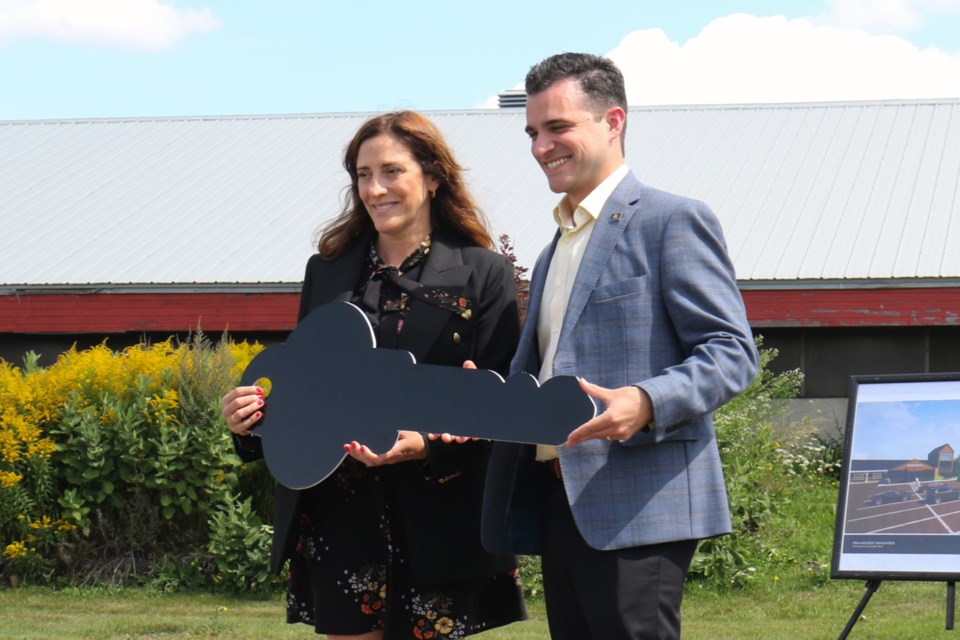A new development promises to breathe new life into a parcel of land on the long-dormant Gateway site in Sault Ste. Marie after a local businessman acquired the property in a deal that closed over the summer.
Tony Porco — whose SIS Group developed much of Sault Ste. Marie's Canal District — joined Mayor Matthew Shoemaker and city officials at the former Mill Market site Friday to unveil plans to develop 3,252 square metres of commercial space at the old fish hatchery site, which had been home to the Mill Market until it permanently relocated beside the downtown plaza and rebranded itself as Soo Market last year.
The old Mill Market location will be retrofitted and converted into a two-storey building that will eventually house the Algoma Makers Market and a new grab-and-go eatery, while the property itself will provide additional space for community activities and events once completed. It’s estimated the project will take up to three years to finish.
Shoemaker called the venture an “exciting and long-awaited development” of a site that has been “central to the discussion of urban renewal and economic development” in the Sault for decades now.
“Positioned in the heart of the Great Lakes, Sault Ste. Marie, and specifically the Gateway site, enjoys stunning views and endless opportunities with the Hub Trail immediately crossing the property,” the mayor said during the announcement. “This area focuses and portrays the best of our community.
“Regrettably, we haven’t always capitalized on that locally. But for 40 years, we have worked on unlocking the benefits of the Gateway site — and it has been a clear priority for our city councils past and present.”
SIS Group purchased the former fish hatchery property from the City of Sault Ste. Marie for $200,000 in a deal that closed June 27, paving the way for the development of the area. The estimated total price tag for the project has not been disclosed.
Canal District spokesperson Melissa Porco said the development at the old fish hatchery site will expand the footprint of the Canal District and the community events it hosts such as Bon Soo, all while offering attractions and activities for tourists who travel here for the Agawa Canyon Tour Train.
“We’ve been waterfront all these years with no view of the water,” she told reporters following the announcement. “We’re excited to be able to be part of the waterfront, part of the Hub Trail, and the plan is to focus on traffic between the two. It will make everything ease of use between the two spaces.”
Much of the Gateway site has been sitting dormant for years as a result of contamination from previous industrial uses, including settling ponds for Algoma Steel. And despite numerous would-be developers bringing forth proposals to the municipality in order to develop the site — including a $53-million plan by developer Philip Garforth to erect a rainforest bio-dome tourist attraction — all three parcels of land that comprise the Gateway site have gone largely underutilized for decades.
More recently, a proposal for a $40 million urban Indigenous hub and housing development was abruptly scrapped by the Bawating Urban Indigenous Committee in 2020.
But now, a parcel of land on the Gateway site has finally been sold off after years of failed attempts at redevelopment. “It has been an objective to get it sold and get it redeveloped, and we’ve got a developer who’s got a proven track record on that,” Shoemaker said.
While some environmental remediation work had to be carried out at the former fish hatchery property, the founder and president of SIS Group said it’s now compliant with all rules and regulations.
“All you heard for the last 50 years was, ‘it’s contaminated.’ Once we did our tests, it wasn’t as bad as everybody thought,” Porco said.
Shoemaker said the city was recently approved for grant funding that will allow the municipality to conduct environmental testing on the remaining two parcels of land that make up the Gateway site.
“We will have that information to be able to market the property, and that will really give people a good, updated sense of what can be developed on those sites,” he said.
It’s anticipated that as many as 60 jobs will be created as a result of the new development. The project also equals tax revenues for the city, in addition to various economic benefits for the community as a whole.
“There will be the economic activity that’s generated here — that will mean a business can expand here, that it could be incubated here and grow from here,” said Shoemaker. “I think there’s all kinds of potential to see what we have seen over the years at The Machine Shop. What you saw grow organically there can be replicated here.”
